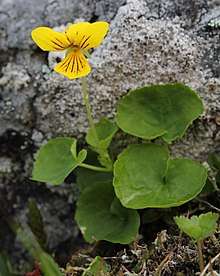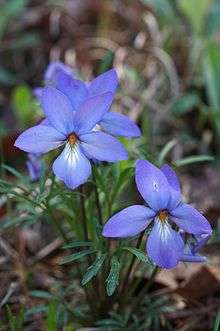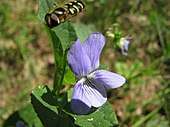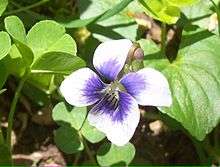Viola (plant)
Viola is a genus of flowering plants in the violet family Violaceae. It is the largest genus in the family, containing between 525 and 600 species. Most species are found in the temperate Northern Hemisphere; however, some are also found in widely divergent areas such as Hawaii, Australasia, and the Andes.
| Viola | |
|---|---|
 | |
| Viola reichenbachiana | |
| Scientific classification | |
| Kingdom: | Plantae |
| Clade: | Tracheophytes |
| Clade: | Angiosperms |
| Clade: | Eudicots |
| Clade: | Rosids |
| Order: | Malpighiales |
| Family: | Violaceae |
| Subfamily: | Violoideae |
| Tribe: | Violeae |
| Genus: | Viola L. |
| Type species | |
| Viola odorata L. | |
| Sections | |
|
see Subdivision | |
Some Viola species are perennial plants, some are annual plants, and a few are small shrubs. Many species, varieties and cultivars are grown in gardens for their ornamental flowers. In horticulture the term pansy is normally used for those multi-colored, large-flowered cultivars which are raised annually or biennially from seed and used extensively in bedding. The terms viola and violet are normally reserved for small-flowered annuals or perennials, including the wild species.
Description
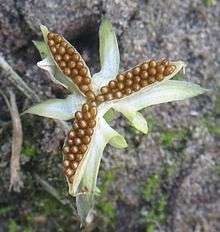
Annual or perennial caulescent or acaulescent (with or without a visible plant stem above the ground) herbs, shrubs or very rarely treelets. In acaulescent taxa the foliage and flowers appear to rise from the ground. The remainder have short stems with foliage and flowers produced in the axils of the leaves (axillary).[1]
Viola typically have heart-shaped or reniform (kidney-shaped), scalloped leaves, though a number have linear or palmate leaves.[1] The simple leaves of plants with either habit are arranged alternately; the acaulescent species produce basal rosettes. Plants always have leaves with stipules that are often leaf-like.
The flowers of the vast majority of the species are strongly zygomorphic with bilateral symmetry and solitary, but occasionally form cymes. The flowers are formed from five petals; four are upswept or fan-shaped with two per side, and there is one, broad, lobed lower petal pointing downward. This petal may be slightly or much shorter than the others and is weakly differentiated. The shape of the petals and placement defines many species, for example, some species have a "spur" on the end of each petal while most have a spur on the lower petal. The spur may vary from scarcely exserted (projecting) to very long, such as in Viola rostrata.[1]
Solitary flowers end long stalks with a pair of bracteoles. The flowers have five sepals that persist after blooming, and in some species the sepals enlarge after blooming. The corolla ranges from white to yellow, orange or various shades of blue and violet or multicolored, often blue and yellow, with or without a yellow throat.[1]
The flowers have five free stamens with short free filaments that are oppressed against the ovary, with a dorsal connective appendage that is large, entire and oblong to ovate. Only the lower two stamens are calcarate (possessing nectary spurs that are inserted on the lowest petal into the spur or a pouch). The styles are filiform (threadlike) or clavate (clubshaped), thickened at their tip, being globose to rostellate (beaked). The stigmas are head-like, narrowed or often beaked. The flowers have a superior ovary with one cell, which has three placentae, containing many ovules.[1]
After flowering, fruit capsules are produced that are thick walled, with few to many seeds per carpel, and dehisce (split open) by way of three valves.[2] On drying, the capsules may eject seeds with considerable force to distances of several meters.[3] The nutlike seeds, which are obovoid to globose, are typically arillate (with a specialized outgrowth) and have straight embryos, flat cotyledons, and soft fleshy endosperm that is oily.[4][1]
Phytochemistry
One characteristic of some Viola is the elusive scent of their flowers; along with terpenes, a major component of the scent is a ketone compound called ionone, which temporarily desensitizes the receptors of the nose, thus preventing any further scent being detected from the flower until the nerves recover.[5]
Taxonomy
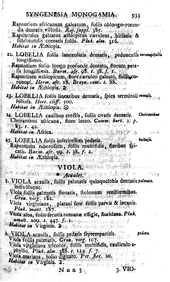
History
First formally described by Carl Linnaeus in 1753[6] with 19 species, the genus Viola bears his botanical authority, L.[7] When Jussieu established the hierarchical system of families (1789), he placed Viola in the Cisti (rock roses),[8] though by 1811 he suggested Viola be separated from these.[9] However, in 1802 Batsch had already established a separate family, which he called Violariae based on Viola as the type genus, with seven other genera.[10][11] Although Violariae continued to be used by some authors, such as Bentham and Hooker in 1862 (as Violarieae),[12] most authors adopted the alternative name Violaceae, first proposed by de Lamarck and de Candolle in 1805,[13] and Gingins (1823)[14] and Saint-Hilaire (1824).[15]However de Candolle also used Violarieae in his 1824 Prodromus.[16]
Phylogeny
Viola is one of about 25 genera and about 600 species in the large family eudicot family Violaceae, divided into sufamilies and tribes. While most genera are monotypic, Viola is a very large genus, variously circumscribed as having between 500-600 species. Historically it was placed in subfamily Violoideae, tribe Violeae. But these divisions have been shown to be artificial and not monophyletic. Molecular phylogenetic studies show that Viola occurs in Clade I of the family, as Viola, Schweiggeria, Noisettia and Allexis, in which Schweiggeria and Noisettia are monotypic and form a sister group to Viola.[17][18][19]
Subdivision
Viola is a large genus, that has traditionally been treated in sections.[18] One of these was that of Gingins (1823),[14] based on stigma morphology, with five sections (Nomimium, Dischidium, Chamaemelanium, Melanium, Leptidium).[20] The extensive taxonomic studies of Wilhelm Becker, culminating in his 1925 conspectus, resulted in 14 sections and many infrasectional groups. The largest and most diverse, being section Viola, with 17 subsections. In addition to subsections, series were also described.[21] Alternatively, some authors have preferred to subdivide the genus into subgenera. Subsequent treatments were by Gershoy (1934)[22] and Clausen (1964),[23] using subsections and series. These were all based on morphological characteristics. Subsequent studies using molecular phylogenetic methods, such as that of Ballard et al. (1998) have shown that many of these traditional divisions are not monophyletic, the problem being related to a high degree of hybridization. In particular section Nomimium was dismembered into several new sections and transferring part of it to section Viola. Section Viola s. lat. is represented by four sections, Viola sensu stricto, Plagiostigma s. str., Nosphinium sensu lato. and the V. spathulata group. In that analysis, the S American sections appear to be the basal groups, starting with Rubellium, then Leptidium. However, the exact phylogenetic relationships remain unresolved, as a consequence many different taxonomic nomenclatures are in use, including groupings referred to as Grex.[19] Marcussen et al. place the five S American sections, Andinium, Leptidium, Tridens, Rubellium and Chilenium at the base of the phylogenetic tree, in that order. These are followed by the single Australian section, Erpetion, as sister group to Chilenium, the northern hemisphere sections and finally the single African section, V. abyssinica. These sections are morphologically, chromosomally, and geographically distinct.[24][25][26]
Sections
Seventeen sections are recognized, listed alphabetically (approximate no. species);[27][24][28]
- Sect. Andinium W.Becker (113) S America[28]
- Sect. Chamaemelanium Ging. s.lat. (61) N America, northeast Asia (includes Dischidium, Orbiculares)
- Subsect. Nudicaules
- Subsect. Nuttalianae
- Sect. Chilenium W.Becker (8) southern S America[29]
- Sect. Danxiaviola W. B. Liao et Q. Fan (1) China[25]
- Sect. Delphiniopsis W.Becker (3) western Eurasia: southern Spain; Balkans[30]
- Sect. Erpetion (Banks) W.Becker (11–18) eastern Australia; Tasmania
- Sect. Leptidium Ging. (19) S America[31]
- Sect. Melanium Ging. (125) western Eurasia (pansies)[18][32]
- Sect. Nosphinium W.Becker s.lat. (31–50) N, C and northern S America; Beringia; Hawaii[27]
- Sect. nov. A (V. abyssinica group) (1–3) Africa: equatorial high mountains
- Sect. nov. B (V. spathulata group) (7–9) western and central Asia: northern Iraq to Mongolia[25]
- Sect. Plagiostigma Godr. (120) northern hemisphere (includes Diffusae)[33][34][35]
- Grex Primulifolia
- Sect. Rubellium W.Becker (3–6) S America: Chile[19]
- Sect. Sclerosium W.Becker (1–4) northeastern Africa to southwestern Asia[36]
- Sect. Tridens W.Becker (2) southern S America
- Sect. Viola s.str. (Rostellatae nom. illeg.) (75) northern hemisphere (violets) (includes Repentes)[26]
- Subsect. Rostratae Kupffer (W.Becker) [37]
- Subsect. Viola ('Rostellatae
- Sect. Xylinosium W.Becker (3–4) Mediterranean region
Species
The genus includes dog violets, a group of scentless species which are the most common Viola in many areas, sweet violet (Viola odorata) (named from its sweet scent), and many other species whose common name includes the word "violet". But other "violets": Neither Saintpaulia ("African violets", Gesneriaceae) nor Erythronium dens-canis ("dogtooth violets", Liliaceae) are related to Viola.
List of selected species
Section AndiniumWith about 113 species, the South American section Andinium is the largest of the Viola sections. It is one of the four sections distributed primarily or exclusively in South America, and the basal group of Viola. New species continue to be identified.[38] Species include;[39] |
Section ChamaemelaniumChamaemelanium was one of a number of sections originally classified on the basis of the shape of the stigma, in this case one that was facial shaped, had an absent beak and had lateral beards. But this section has subsequently been shown to be paraphyletic, requiring revision. It occurs at high altitudes (above 600 m) in both N America and northeast Asia, including Siberia and Korea, and the species are perennial, caulous and herbaceous.[41] With about 61 species including;
|
Viola reichei Section ChileniumA small S American section with about 8 species, as sister group to Erpetion, including;
|
Section Danxiaviola
- Viola hybanthoides
Section Delphiniopsis
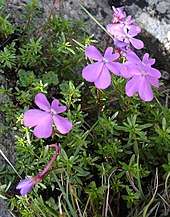
- Viola cazorlensis
- Viola delphinantha
- Viola kosaninii
Section Erpetion[42]
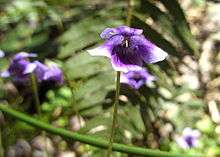
- Viola banksii – Australian native violet, ivy-leaved violet
- Viola hederacea – Australian native violet, ivy-leaved violet
Section Leptidium
Section Melanium (pansies)[18][43]
- Viola arvensis – field pansy
- Viola bicolor
- Viola pedunculata – yellow pansy, Pacific coast.
- Viola bertolonii
- Viola calcarata
- Viola cheiranthifolia – Teide violet
- Viola cornuta
- Viola lutea
- Viola tricolor – wild pansy, heartsease
Section Nosphinium
Section A (V. abyssinica group)
Section B (V. spathulata group)
- Viola spathulata
Section Plagiostigma
Section Rubellium
Section Sclerosium
- Viola cinerea
Section Tridens
.jpg)
- Viola tridentata – mountain violet
Section Viola (violets)
- Viola canina – heath dog violet
- Viola hirta – hairy violet
- Viola labradorica – alpine violet
- Viola odorata – sweet violet
- Viola persicifolia – fen violet
- Viola riviniana – common dog violet
- Viola rostrata – long-spurred violet
- Viola sororia – common blue violet, hooded violet
Section Xylinosium
Evolution and biogeography
One fossil seed of †Viola rimosa has been extracted from borehole samples of the Middle Miocene fresh water deposits in Nowy Sacz Basin, West Carpathians, Poland.[46] The genus is thought to have arisen in S America, most likely the Andes.[18][19]
Genetics
Habitat fragmentation has been shown to have minimal effect on the genetic diversity and gene flow of the North American woodland violet Viola pubescens.[47] This may be partially attributed to the ability of Viola pubescens to continue to persist within a largely agricultural matrix.[48] This trend of unexpectedly high genetic diversity is also observed in Viola palmensis, a Canary Island endemic known only from a 15 square kilometer range on La palma island.[49] High levels of genetic diversity within these species indicate that these plants are outcrossing, even though many violet species can produce many clonal offspring throughout the year via cleistogamous flowers. Plants that produce copious amounts of clonal seeds from cleistogmaous flowers often experience increased levels of inbreeding.[50] These reportedly high rates of outcrossing and genetic diversity indicate that these violets are strong competitors for pollinators during the early spring when they are in bloom and that those pollinators can travel considerable distances between often fragmented populations.
Distribution and habitat
The worldwide northern temperate distribution of the genus distinguishes it from the remaining largely tropical Violaceae genera, restricted to either Old World or New World species, while in the tropics the distribution is primarily in high mountainous areas.[1] Centres of diversity occur mainly in the northern hemisphere, in mountainous regions of eastern Asia, Melanesia, and southern Europe, but also occur in the Andes and the southern Patagonian cone of South America.[39] One of the highest species concentrations is in the former USSR.[20] Australia is home to a number of Viola species, including Viola hederacea, Viola betonicifolia and Viola banksii, first collected by Joseph Banks and Daniel Solander on the Cook voyage to Botany Bay.[18]
Ecology
Viola species are used as food plants by the larvae of some Lepidoptera species, including the giant leopard moth, large yellow underwing, lesser broad-bordered yellow underwing, high brown fritillary, small pearl-bordered fritillary, pearl-bordered fritillary, regal fritillary, cardinal, and Setaceous Hebrew character. The larvae of many fritilary butterfly species use violets as an obligate host plant, although these butterflies do not always ovaposit directly onto violets.[51] While the ecology of this genera is extremely diverse, violets are mainly pollinated by members within the orders diptera and hymenoptera.[52] Showy flowers are produced in early spring and clonal cleistogamous flowers are produced from late spring until the end of the growing season under favorable conditions. Cleistogamy allows plants to produce offspring year round and have more chances for establishment.[53] This system is especially important in violets, as these plants are often weak competitors for pollination due to their small size.
Many violet species exhibit two modes of seed dispersal. Once seed capsules have matured, seeds are dispelled around the plant through explosive dehiscence.[54] Viola pedata seeds have been reported being dispersed distances of up to 5 meters away from the parent plant.[54] Often, seeds are then further dispersed by ants through a process called myrmecochory.[55] Violets whose seeds are dispersed this way have specialized structures on the exterior of the seeds called elaiosomes. This interaction allows violet seed to germinate and establish in a protected, stable environment.[54]
Many violet seeds exhibit physiological dormancy and require some period of cold stratification to induce germination under ex situ conditions.[56] Rates of germination are often quite poor, especially when seeds are stored for extended periods of time.[57] In North American habitat restoration, native violets are in high demand due to their relationship with the aforementioned fritillary butterflies.[58]
Violet species occupy a diverse array of habitats, from bogs (Viola lanceolata) to dry hill prairies (Viola pedata) to woodland understories (Viola labradorica). While many of these species are indicators of high quality habitat, some violets are capable of thriving in a human altered landscape. Two species of zinc violet (Viola calaminaria and Viola guestphalica) are capable of living in soils severely contaminated with heavy metals.[59] Many violets form relationships with Arbuscular mycorrhizal fungi and in the case of the zinc violets, this relationship allows these plants to tolerate such highly contaminated soils.
Flowering is often profuse, and may last for much of the spring and summer. Viola are most often spring blooming with chasmogamous flowers with well-developed petals pollinated by insects. Many species also produce self-pollinated cleistogamous flowers in summer and autumn that do not open and lack petals.[60] In some species the showy chasmogamous flowers are infertile (e.g.,Viola sororia).[lower-alpha 1][61]
Horticultural uses
The international registration authority for the genus is the American Violet Society, where growers register new Viola cultivars.[62] A coding system is used for cultivar description of ten horticultural divisions, such as Violet (Vt) and Violetta (Vtta).[63] Examples include Viola 'Little David' (Vtta)[64] and Viola 'Königin Charlotte' (Vt).[65]
In this system violets (Vt) are defined as "stoloniferous perennials with small, highly fragrant, self-coloured purple, blue or white flowers in late winter and early spring".[63]
Species and cultivars

Many species, varieties and cultivars are grown in gardens for their ornamental flowers. In horticulture the term pansy is normally used for those multi-colored, large-flowered cultivars which are raised annually or biennially from seed and used extensively in bedding. The terms viola and violet are normally reserved for small-flowered annuals or perennials, including the wild species.[62][63]
Cultivars of Viola cornuta, Viola cucullata, and Viola odorata, are commonly grown from seed. Other species often grown include Viola labradorica, Viola pedata, and Viola rotundifolia.[66]
The modern garden pansy (V. × wittrockiana) is a plant of complex hybrid origin involving at least three species, V. tricolor (wild pansy or heartsease), V. altaica, and V. lutea (mountain pansy).[67] The hybrid horned pansy (V. × williamsii) originates from hybridization involving garden pansy and Viola cornuta.[68]
Bedding plants
In 2005 in the United States, Viola cultivars (including pansies) were one of the top three bedding plant crops and 111 million dollars worth of flats of Viola were produced for the bedding flower market. Pansies and violas used for bedding are generally raised from seed, and F1 hybrid seed strains have been developed which produce compact plants of reasonably consistent flower coloring and appearance. Bedding plants are usually discarded after one growing season.[69]
Perennial cultivars

There are hundreds of perennial viola and violetta cultivars; many of these do not breed true from seed and therefore have to be propagated from cuttings. Violettas can be distinguished from violas by the lack of ray markings on their petals.[62] The following cultivars, of mixed or uncertain parentage, have gained the Royal Horticultural Society's Award of Garden Merit;[70]
- 'Aspasia'[71]
- 'Clementina'[72]
- 'Huntercombe Purple'[73]
- 'Little David' (Vtta)[64]
- 'Moonlight'[74]
- 'Nellie Britton'[75]
Other popular examples include:[76]
- 'Ardross Gem' (viola)
- 'Blackjack'
- 'Buttercup' (violetta)
- 'Columbine' (viola)
- 'Dawn' (violetta)
- 'Etain' (viola)
- 'Irish Molly' (viola)
- 'Jackanapes' (viola)
- 'Maggie Mott' (viola)
- 'Martin' (viola)
- 'Molly Sanderson' (viola)
- 'Rebecca' (violetta)
- 'Vita' (viola)
- 'Zoe' (violetta)
Other uses
Culinary
When newly opened, Viola flowers may be used to decorate salads or in stuffings for poultry or fish. Soufflés, cream, and similar desserts can be flavoured with essence of Viola flowers. The young leaves are edible raw or cooked as a somewhat bland leaf vegetable. The flowers and leaves of the cultivar 'Rebecca', one of the Violetta violets, have a distinct vanilla flavor with hints of wintergreen. The pungent perfume of some varieties of V. odorata adds inimitable sweetness to desserts, fruit salads, and teas while the mild pea flavor of V. tricolor combines equally well with sweet or savory foods, like grilled meats and steamed vegetables. The heart-shaped leaves of V. odorata provide a free source of greens throughout a long growing season,[77] while the petals are used for fragrant flavoring in milk puddings and ice cream or in salads and as garnishes.[78][79]
A candied violet or crystallized violet is a flower, usually of Viola odorata, preserved by a coating of egg white and crystallised sugar. Alternatively, hot syrup is poured over the fresh flower (or the flower is immersed in the syrup) and stirred until the sugar recrystallizes and has dried. This method is still used for rose petals and was applied to orange flowers in the past (when almonds or orange peel are treated this way they are called pralines). Candied violets are still made commercially in Toulouse, France, where they are known as violettes de Toulouse. They are used as decorating cakes or trifles or included in aromatic desserts.[78][79]
The French are also known for their violet syrup, most commonly made from an extract of violets. In the United States, this French violet syrup is used to make violet scones and marshmallows. Viola essence flavours the liqueurs Creme Yvette, Creme de Violette, and Parfait d'Amour. It is also used in confectionery, such as Parma Violets and C. Howard's Violet candies.
Medicinal
Many Viola species contain antioxidants called anthocyanins. Fourteen anthocyanins from V. yedoensis and V. prionantha have been identified. Some anthocyanins show strong antioxidant activities.[80] Most violas tested and many other plants of the family Violaceae contain cyclotides,[81][82][83] which have a diverse range of in vitro biological activities when isolated from the plant, including uterotonic, anti-HIV, antimicrobial, and insecticidal activities.[84] Viola canescens, a species from India, exhibited in vitro activity against Trypanosoma cruzi.[85]
Viola has been evaluated in different clinical indications in human studies. A double blind clinical trial showed that the adjuvant use of Viola odorata syrup with short-acting β-agonists can improve the cough suppression in children with asthma.[86][87] In another study intranasal administration of Viola odorata extract oil showed to be effective in patients with insomnia.[87] Topical use of an herbal formulation containing Viola tricolor extract also showed promising effects in patients with mild-to-moderate atopic dermatitis.[88]
Perfume
Viola odorata is used as a source for scents in the perfume industry. Violet is known to have a 'flirty' scent as its fragrance comes and goes. Ionone is present in the flowers, which turns off the ability for humans to smell the fragrant compound for moments at a time.[89]
Cultural associations
Birth
Violet is the traditional birth flower for February in English tradition.[90]
Geographical territories
In the United States, the common blue violet Viola sororia is the state flower of Illinois,[91] Rhode Island,[92] New Jersey[93] and Wisconsin,[94][95] In Canada, the Viola cucullata is the provincial flower of New Brunswick adopted in 1936[96] In the United Kingdom, Viola riviniana is the county flower of Lincolnshire.[97]
Lesbian and bisexual culture
Violets became symbolically associated with love between women.[98][99] This connection originates from fragments of a poem by Sappho about a lost love, in which she describes her as "Close by my side you put around yourself [many wreaths] of violets and roses."[100] In another poem, Sappho describes her lost love as wearing "violet tiaras, braided rosebuds, dill and crocus twined around" her neck.[101] In 1926, one of the first plays to involve a lesbian relationship, La Prisonnière by Édouard Bourdet, used a bouquet of violets to signify lesbian love.[102][103]
Tributes
Violets, and badges depicting them,[104][105] were sold in fund-raising efforts in Australia and New Zealand on and around Violet Day[106] in commemoration of the lost soldiers of World War I.[107]
See also
- Rosalia (festival), a festival of roses which sometimes involved violas
- Pansy
Notes
- V. papilionacea is considered a synonym of V. sororia
References
- Ballard et al 2013.
- Cullen 2001, p. 345.
- Rendle 1925, p. 208.
- Cronquist 1981.
- Maxwell 2017.
- Linnaeus 1753.
- WFO 2019.
- Jussieu 1789.
- Lindley 1853.
- Batsch 1802.
- IPNI 2020.
- Bentham & Hooker 1862.
- de Lamarck & de Candolle 1815.
- Gingins 1823.
- Saint-Hilaire 1824.
- Candolle 1824.
- Wahlert et al 2014.
- Yockteng et al 2003.
- Ballard et al 1998.
- Yoo & Jang 2010.
- Becker 1925.
- Gershoy 1934.
- Clausen 1964.
- Marcussen et al 2015.
- Fan et al 2015.
- Malobecki et al 2016.
- Marcussen et al 2012.
- Watson et al 2019.
- BioLib 2019.
- CSIC 2020.
- Freitas & Sosa 2002.
- Magrini & Scoppola 2015.
- Ning 2012.
- Zhou 2008.
- Tikhomirov 2015.
- Shahrestani et al 2014.
- Danihelka 2010.
- Gonzáles & Cano 2016.
- Ballard & Iltis 2012.
- Watson & Flores 2003.
- Whang 2002.
- Thiele & Prober 2003.
- Chervin et al 2019.
- V capillaris 2020.
- Watson & Watson 2012.
- Łańcucka-Środoniowa 1979.
- Culley et al 2007.
- Culley & Grubb 2003.
- Batista & Sosa 2002.
- Culley & Klooster 2007.
- Kopper et al 2000.
- Beattie 1971.
- Lord 1981.
- Beattie & Lyons 1975.
- Culver & Beattie 1978.
- Baskin & Baskin 1972.
- Elisafenko 2015.
- Shuey et al 2016.
- Hildebrandt et al 1999.
- Walters & Keil 1996, p. 332.
- VC 2020.
- AVS 2007.
- RHS 2009.
- RHS Little David 2020.
- RHS Konigin Charlotte 2020.
- Armitage 2008.
- Wittrock 1892–1897a.
- Wittrock 1892–1897.
- Kelly et al 2007.
- RHS 2018.
- "RHS Plant Selector Viola 'Aspasia'". Archived from the original on 17 May 2013. Retrieved 8 June 2013.
- "RHS Plant Selector Viola 'Clementina'". Archived from the original on 17 May 2013. Retrieved 8 June 2013.
- "RHS Plant Selector Viola 'Huntercombe Purple'". Archived from the original on 17 May 2013. Retrieved 8 June 2013.
- "RHS Plant Selector Viola 'Moonlight'". Archived from the original on 17 May 2013. Retrieved 8 June 2013.
- "RHS Plant Selector Viola 'Nellie Britton'". Retrieved 8 June 2013.
- RHS Plant Finder 2008-2009, Dorling Kindersley (2008) ISBN 978-1-4053-3190-6 pp787–791
- Whittaker, Debbie. "Cooking and Decorating With Violets". The Culinary Violet. The American Violet Society. Archived from the original on 2012-02-23. Retrieved 2012-02-09.
- Davidson 2014.
- Robuchon 1997.
- Zhang, J.; et al. (2011). "Rapid separation and identification of anthocyanins from flowers of Viola yedoensis and V. prionantha by high-performance liquid chromatography-photodiode array detection-electrospray ionisation mass spectrometry". Phytochemical Analysis. 23 (1): 16–22. doi:10.1002/pca.1320. PMID 21523841.
- Tang, J.; et al. (2010). "Isolation and characterization of cytotoxic cyclotides from Viola tricolor" (PDF). Peptides. 31 (8): 1434–40. doi:10.1016/j.peptides.2010.05.004. PMID 20580652. Archived from the original (PDF) on 2013-07-18. Retrieved 2013-07-03.
- Trabi, M.; et al. (2009). "Circular proteins from Melicytus (Violaceae) refine the conserved protein and gene architecture of cyclotides". Organic and Biomolecular Chemistry. 7 (11): 2378–88. doi:10.1039/b823020j. PMID 19462049.
- Gerlach, S. L.; et al. (2010). "Isolation, characterization, and bioactivity of cyclotides from the Micronesian plant Psychotria leptothyrsa". Journal of Natural Products. 73 (7): 1207–13. doi:10.1021/np9007365. PMID 20575512.
- Craik, David J. (2010). "Discovery and applications of the plant cyclotides". Toxicon. 56 (7): 1092–1102. doi:10.1016/j.toxicon.2010.02.021. PMID 20219513.
- Dua, VK; Verma, G; Agarwal, DD; Kaiser, M; Brun, R (Apr 2011). "Antiprotozoal activities of traditional medicinal plants from the Garhwal region of North West Himalaya, India". Journal of Ethnopharmacology. 136 (1): 123–128. doi:10.1016/j.jep.2011.04.024. PMID 21527328.
- Qasemzadeh, MJ; Sharifi, H; Hamedanian, M; Gharehbeglou, M; Heydari, M; Sardari, M; Akhlaghdoust, M; Minae, MB (Oct 2015). "The Effect of Viola odorata Flower Syrup on the Cough of Children With Asthma: A Double-Blind, Randomized Controlled Trial". Journal of Evidence-Based Complementary & Alternative Medicine. 20 (4): 287–91. doi:10.1177/2156587215584862. PMID 25954025.
- Staff, Thomson P.D.R (2004-01-01). PDR for Herbal Medicines. ISBN 9781563635120. Archived from the original on 2015-11-30.
- Klövekorn, W; Tepe, A; Danesch, U (Nov 2007). "A randomized, double-blind, vehicle-controlled, half-side comparison with a herbal ointment containing Mahonia aquifolium, Viola tricolor and Centella asiatica for the treatment of mild-to-moderate atopic dermatitis". Int J Clin Pharmacol Ther. 45 (11): 583–91. doi:10.5414/CPP45583. PMID 18077922.
- Ackerman, Diane. A natural history of the senses. New York: Vintage Books, 1991. Print.
- Almanac, Old Farmer's. "Birth Month Flowers and Their Meanings".
- "State Symbols". State of Illinois.
- "Rhode Island State Flower - Violet". statesymbolsusa.org.
- "New Jersey State Flower - Violet". statesymbolsusa.org.
- "Wisconsin State Symbols". State of Wisconsin. Archived from the original on 2010-01-12. Retrieved 2011-12-19.
- "Wisconsin State Flower - Wood Violet". statesymbolsusa.org. Rhode Island and Illinois.
- "New Brunswick". Government of Canada. 2013-08-28. Retrieved 2015-07-18.
- "Dog-violet (Common)". Plantlife.
- Myers, JoAnne (2003). The A to Z of the Lesbian Liberation Movement: Still the Rage (The A to Z Guide Series, No. 73 ) (1st ed.). Lanham, Maryland: The Scarecrow Press. p. 242. ISBN 978-0-8108-6811-3.
- "Gay Symbols Through the Ages". The Alyson Almanac: A Treasury of Information for the Gay and Lesbian Community. Boston, Massachusetts: Alyson Publications. 1989. p. 100. ISBN 978-0-932870-19-3.
- Collecott, Diana (1999). H.D. and Sapphic Modernism 1910-1950 (1st ed.). Cambridge, UK: Cambridge University Press. p. 216. ISBN 978-0-521-55078-9.
- Barnard, Mary (1958). Sappho: A New Translation (1st ed.). University of California Press. p. 42. (LCCN 58-6520)
- Cohen-Stratyner, Barbara (January 14, 2014). "Violets and Vandamm". New York Public Library. Retrieved 4 October 2018.
- Sova, Dawn B. (2004). Banned Plays: Censorship Histories of 125 Stage Dramas (1st ed.). Facts On File. pp. 37–40. ISBN 978-0-8160-4018-6.
- NMA Collections Search Archived 2014-05-31 at the Wayback Machine National Museum of Australia (2003-2010) - Violet Day 1917 fundraising badge
- Gracie, Carol (2012), Spring Wildflowers of the Northeast: A Natural History, Princeton, NJ: Princeton University Press, p. 221, ISBN 978-0691144665
- Family History South Australia Archived 2013-11-09 at the Wayback Machine Leadbeater, B (2006). World War 1 Violet Day South Australia.
- "Violet Day, Press, 3 September 1914, p.8, col. 8" (Newspaper). The National Library of New Zealand. 3 September 1914. p. 8. Archived from the original on 5 March 2016. Retrieved 10 November 2015.
Bibliography
Books
- Armitage, Allan M. (1 May 2008) [1989]. "Viola". Herbaceous Perennial Plants: A Treatise on their Identification, Culture, and Garden Attributes (3rd ed.). Cool Springs Press. pp. 1038ff. ISBN 978-1-61058-380-0.CS1 maint: ref=harv (link)(additional excerpts)
- Ballard, Harvey E; Paula-Souza, Juliana de; Wahlert, Gregory A (2013). "Violaceae". In Kubitzki, Klaus (ed.). Flowering Plants. 11 Eudicots: Malpighiales. Springer Science & Business Media. pp. 303–322. ISBN 978-3-642-39417-1.(Also preview at Springer)
- Becker, Wilhelm (1925) [1887–1915]. "Viola". In Engler, Adolf; Prantl, Karl (eds.). Die natürlichen Pflanzenfamilien nebst ihren Gattungen und wichtigeren Arten, insbesondere den Nutzpflanzen, unter Mitwirkung zahlreicher hervorragender Fachgelehrten (in German). 21 (2nd ed.). Berlin: Duncker & Humblot. pp. 363–376.CS1 maint: ref=harv (link)
- Cronquist, Arthur (1981). An integrated system of classification of flowering plants. New York: Columbia University Press. p. 404.CS1 maint: ref=harv (link)
- Cullen, James, ed. (2001). Handbook of North European Garden Plants: With Keys to Families and Genera. Cambridge University Press. ISBN 978-0-521-00411-4.CS1 maint: ref=harv (link)
- Walters, S M (2011) [1984]. "Viola Linnaeus". In Cullen, James; Knees, Sabina G.; Cubey, H. Suzanne (eds.). The European Garden Flora Flowering Plants: A Manual for the Identification of Plants Cultivated in Europe, Both Out-of-Doors and Under Glass. Vol IV Aquifoliaceae - Hydropyhllacea (2nd ed.). Cambridge University Press. pp. 102–107. ISBN 978-0-521-76160-4.CS1 maint: ref=harv (link)
- Davidson, Alan (2014). "Violet". The Oxford Companion to Food. Oxford University Press. ISBN 978-0-19-967733-7.CS1 maint: ref=harv (link), see also The Oxford Companion to Food
- Gershoy, A (1934). Studies in North American violets. III. Chromosome numbers and species characters. Bulletin no. 367. Vermont Agricultural Experiment Station.CS1 maint: ref=harv (link)
- Maxwell, Catherine (2017). "Perfumed melodies, Violet memories: Scent and remembrance in the nineteenth century". Scents and Sensibility: Perfume in Victorian Literary Culture. OUP Oxford. pp. 66–84. ISBN 978-0-19-100521-3.CS1 maint: ref=harv (link)(additional excerpts as e-book)
- Robuchon, Joël, ed. (1997). "Violette". Larousse gastronomique. Larousse. p. 1106. ISBN 978-2-03-560227-5.CS1 maint: ref=harv (link), (see also Larousse Gastronomique)
- Rendle, Alfred Barton (1925). The Classification of Flowering Plants: Volume 2, Dicotyledons. CUP Archive. ISBN 978-0-521-06057-8.CS1 maint: ref=harv (link)(Full text available at BHL)
- Walters, Dirk R.; Keil, David J. (1996). Vascular Plant Taxonomy (4th ed.). Kendall/Hunt Publishing Company. ISBN 978-0-7872-2108-9.CS1 maint: ref=harv (link), (also available at Google Books)
- Historical sources
- Batsch, August Johann Georg Karl (1802). "Violariae". Tabula affinitatum regni vegetabilis, quam delineavit, et nunc ulterius adumbratam (in Latin). Weimar: Landes-Industrie-Comptoir. pp. 57–59.CS1 maint: ref=harv (link)
- Bentham, G.; Hooker, J.D. (1862). "Violarieae". Genera plantarum ad exemplaria imprimis in herbariis kewensibus servata definita (3 vols.). 1. London: L Reeve & Co. pp. 114–121.CS1 maint: ref=harv (link)
- de Candolle, A. P. (1824–1873). "Violarieae". Prodromus systematis naturalis regni vegetabilis, sive, Enumeratio contracta ordinum generum specierumque plantarum huc usque cognitarium, juxta methodi naturalis, normas digesta 17 vols. 1. Paris: Treuttel et Würtz. pp. 287–316.
- Jussieu, Antoine Laurent de (1789). "Cisti: Viola". Genera plantarum: secundum ordines naturales disposita, juxta methodum in Horto regio parisiensi exaratam, anno M.DCC.LXXIV (in Latin). Paris. p. 294. OCLC 5161409.CS1 maint: ref=harv (link)
- de Lamarck, Jean-Baptiste; de Candolle, AP (1815) [1805]. "Violaceae". Flore française ou descriptions succinctes de toutes les plantes qui croissent naturellement en France disposées selon une nouvelle méthode d'analyse; et précédées par un exposé des principes élémentaires de la botanique (in French). IV(2) (3rd ed.). Paris: Desray. pp. 801−810.CS1 maint: ref=harv (link) (Latin Index page 931)
- Lindley, John (1853) [1846]. "Violaceae". The Vegetable Kingdom: or, The structure, classification, and uses of plants, illustrated upon the natural system (3rd. ed.). London: Bradbury & Evans. pp. 338−339.CS1 maint: ref=harv (link)
- Linnaeus, Carl (1753). "Viola". Species Plantarum: exhibentes plantas rite cognitas, ad genera relatas, cum differentiis specificis, nominibus trivialibus, synonymis selectis, locis natalibus, secundum systema sexuale digestas. 2. Stockholm: Impensis Laurentii Salvii. pp. 933–937.CS1 maint: ref=harv (link), see also Species Plantarum
Articles
- Baskin, Jerry M.; Baskin, Carol C. (November 1972). "Physiological Ecology of Germination of Viola rafinesquii". American Journal of Botany. 59 (10): 981–988. doi:10.2307/2441480. JSTOR 2441480.CS1 maint: ref=harv (link)}
- Batista, Francisco; Sosa, Pedro A. (31 October 2002). "Allozyme Diversity in Natural Populations of Viola palmensis Webb & Berth. (Violaceae) from La Palma (Canary Islands): Implications for Conservation Genetics". Annals of Botany. 90 (6): 725–733. doi:10.1093/aob/mcf256. PMC 4240367. PMID 12451028.CS1 maint: ref=harv (link)
- Beattie, A. J. (March 1971). "Pollination Mechanisms in Viola". New Phytologist. 70 (2): 343–360. doi:10.1111/j.1469-8137.1971.tb02533.x.CS1 maint: ref=harv (link)
- Beattie, A. J.; Lyons, N. (August 1975). "Seed Dispersal in Viola (Violaceae): Adaptations and Strategies". American Journal of Botany. 62 (7): 714–722. doi:10.2307/2442060. JSTOR 2442060.CS1 maint: ref=harv (link)
- Clausen, Jens (1964). "Cytotaxonomy and distributional ecology of western North American violets". Madroño. 17 (6): 173–197. ISSN 0024-9637. JSTOR 41423141.CS1 maint: ref=harv (link), also at BHL
- Culley, Theresa M.; Grubb, Thomas C. (1 October 2003). "Genetic effects of habitat fragmentation in Viola pubescens (Violaceae), a perennial herb with chasmogamous and cleistogamous flowers". Molecular Ecology. 12 (11): 2919–2930. doi:10.1046/j.1365-294X.2003.01971.x. PMID 14629373.CS1 maint: ref=harv (link)
- Culley, Theresa M.; Klooster, Matthew R. (January 2007). "The Cleistogamous Breeding System: A Review of Its Frequency, Evolution, and Ecology in Angiosperms". The Botanical Review. 73 (1): 1–30. doi:10.1663/0006-8101(2007)73[1:TCBSAR]2.0.CO;2.CS1 maint: ref=harv (link)
- Culley, T. M.; Sbita, S. J.; Wick, A. (13 March 2007). "Population Genetic Effects of Urban Habitat Fragmentation in the Perennial Herb Viola pubescens (Violaceae) using ISSR Markers". Annals of Botany. 100 (1): 91–100. doi:10.1093/aob/mcm077. PMC 2735295. PMID 17556381.
- Culver, David C.; Beattie, Andrew J. (March 1978). "Myrmecochory in Viola: Dynamics of Seed-Ant Interactions in Some West Virginia Species". The Journal of Ecology. 66 (1): 53–72. doi:10.2307/2259181. JSTOR 2259181.CS1 maint: ref=harv (link)
- Elisafenko, T. V. (19 August 2015). "Features of seed germination in different ecological groups of the species of the section Violidum, subgenus Nomimium, genus Viola L. (Violaceae)". Contemporary Problems of Ecology. 8 (4): 523–533. doi:10.1134/S199542551504006X.CS1 maint: ref=harv (link)
- Freitas, L.; Sosa, M. (19 December 2002). "Floral Biology and Pollination Mechanisms in Two Viola Species-From Nectar to Pollen Flowers?". Annals of Botany. 91 (3): 311–317. doi:10.1093/aob/mcg025. PMC 4244963. PMID 12547683.CS1 maint: ref=harv (link)
- Hildebrandt, U.; Kaldorf, M.; Bothe, H. (May 1999). "The Zinc Violet and its Colonization by Arbuscular Mycorrhizal Fungi". Journal of Plant Physiology. 154 (5–6): 709–717. doi:10.1016/S0176-1617(99)80249-1.
- Kopper, Brian J.; Charlton, Ralph E.; Margolies, David C. (2000). "Oviposition Site Selection by the Regal Fritillary, Speyeria idalia, as Affected by Proximity of Violet Host Plants". Journal of Insect Behavior. 13 (5): 651–665. doi:10.1023/A:1007887809621.
- Łańcucka-Środoniowa, Maria (1979). "Macroscopic plant remains from the freshwater Miocene of the Nowy Sącz Basin (West Carpathians, Poland)". Acta Palaeobotanica. 20 (1): 3–117.CS1 maint: ref=harv (link)
- Lord, E. M. (October 1981). "Cleistogamy: A tool for the study of floral morphogenesis, function and evolution". The Botanical Review. 47 (4): 421–449. doi:10.1007/BF02860538. JSTOR 4353990.CS1 maint: ref=harv (link)
- Park, Sungkyu; et al. (2017). "Cyclotide evolution: Insights from the analyses of their precursor sequences, structures and distribution in Violets (Viola)". Frontiers in Plant Science. 8: 92–110. doi:10.3389/fpls.2017.02058. PMC 5741643. PMID 29326730.CS1 maint: ref=harv (link)
- Saint-Hilaire, Augustin (1824). "Tableau monographique des plantes de la flore du Brésil méridional appartenant au groupe (classe Br.) qui comprend qui comprend les Droséracées, les Violacées, les Cistinées et les Frankenicées: Violacées". Annales du museum national d'histoire naturelle (in French). 72: 445–498.CS1 maint: ref=harv (link)
- Shuey, John; Jacquart, Ellen; Orr, Stuart; Becker, Fiona; Nyberg, Alyssa; Littiken, Robert; Anchor, Ted; Luchik, Derek (9 September 2016). "Landscape-scale response to local habitat restoration in the regal fritillary butterfly (Speyeria idalia) (Lepidoptera: Nymphalidae)". Journal of Insect Conservation. 20 (5): 773–780. doi:10.1007/s10841-016-9908-4.
- Thiele, Kevin R; Prober, Suzanne M (2003). "New species and a new hybrid in the Viola hederacea species complex, with notes on Viola hederacea Labill". Muelleria. 18: 7–25.CS1 maint: ref=harv (link)
- Tikhomirov, V. N (2015). "A revision of the genus Viola section Plagiostigma (Violaceae) in Republic of Belarus". Botanicheskiĭ Zhurnal (in Russian). 100 (5): 490–500.CS1 maint: ref=harv (link)
- Yockteng, R.; Jr Ballard, H. E.; Mansion, G.; Dajoz, I.; Nadot, S. (1 November 2003). "Relationships among pansies ( Viola section Melanium ) investigated using ITS and ISSR markers". Plant Systematics and Evolution. 241 (3–4): 153–170. CiteSeerX 10.1.1.721.5590. doi:10.1007/s00606-003-0045-7. JSTOR 23645153.
- Wahlert, Gregory A.; Marcussen, Thomas; de Paula-Souza, Juliana; Feng, Min; Ballard, Harvey E. (1 March 2014). "A Phylogeny of the Violaceae (Malpighiales) Inferred from Plastid DNA Sequences: Implications for Generic Diversity and Intrafamilial Classification". Systematic Botany. 39 (1): 239–252. doi:10.1600/036364414X678008.
- Watson, John M.; Flores, R. (2003). "A new name in section Andinium W.becker of the genus Viola L. (Violaceae)". Gayana. Botánica. 60 (2). doi:10.4067/S0717-66432003000200009.CS1 maint: ref=harv (link)
- Watson, John M.; Flores, Ana R.; Arroyo-Leuenberger, Silvia C. (25 March 2019). "A new Viola (Violaceae) from the Argentinian Andes". Willdenowia. 49 (1): 35. doi:10.3372/wi.49.49105.
- Watson, John; Watson, Anita (Fall 2012). "Fire and Ice: Rosulate Viola Evolution Part One – The Stage is Set" (PDF). North American Rock Garden Society Quarterly. 70 (4): 360–366.CS1 maint: ref=harv (link)
- Yoo, Ki-Oug; Jang, Su-Kil (November 2010). "Infrageneric relationships of Korean Viola based on eight chloroplast markers". Journal of Systematics and Evolution. 48 (6): 474–481. doi:10.1111/j.1759-6831.2010.00102.x.CS1 maint: ref=harv (link)
- Zhou, J. S.; et al. (2008). "Viola nanlingensis (Violaceae), a new species from Guangdong, southern China" (PDF). Annales Botanici Fennici. 45 (3): 233–36. doi:10.5735/085.045.0312.CS1 maint: ref=harv (link)
Phylogeny and taxonomy
- Ballard, Harvey E.; Sytsma, Kenneth J. (October 2000). "Evolution And Biogeography Of The Woody Hawaiian Violets (Viola, Violaceae): Arctic Origins, Herbaceous Ancestry And Bird Dispersal". Evolution. 54 (5): 1521–1532. doi:10.1111/j.0014-3820.2000.tb00698.x. PMID 11108581.CS1 maint: ref=harv (link)
- Ballard, Harvey E.; Sytsma, Kenneth J.; Kowal, Robert R. (October 1998). "Shrinking the Violets: Phylogenetic Relationships of Infrageneric Groups in Viola (Violaceae) Based on Internal Transcribed Spacer DNA Sequences" (PDF). Systematic Botany. 23 (4): 439. doi:10.2307/2419376. JSTOR 2419376.
- Ballard, Harvey E; Iltis, Hugh H (2012). "Viola lilliputana sp. nov. (Viola sect. Andinium, Violaceae), one of the world's smallest violets, from the Andes of Peru". Brittonia. 64 (4): 353–358. doi:10.1007/s12228-012-9238-0.CS1 maint: ref=harv (link)
- Chervin, Justine; Talou, Thierry; Audonnet, Marjorie; Dumas, Bernard; Camborde, Laurent; Esquerré-Tugayé, Marie-Thérèse; Roux, Christophe; Cabanac, Guillaume; Marti, Guillaume (July 2019). "Deciphering the phylogeny of violets based on multiplexed genetic and metabolomic approaches" (PDF). Phytochemistry. 163: 99–110. doi:10.1016/j.phytochem.2019.04.001. PMID 31035059.
- Danihelka, Jiří; et al. (December 2010). "Viola montana and V. persicifolia (Violaceae): Two names to be rejected". Taxon. 59 (6): 1869–1878. doi:10.1002/tax.596019. JSTOR 41059881.CS1 maint: ref=harv (link)
- Fan, Qiang; Chen, Sufang; Wang, Longyuan; Chen, Zaixiong; Liao, Wenbo (4 February 2015). "A new species and new section of Viola (Violaceae) from Guangdong, China". Phytotaxa. 197 (1): 15. doi:10.11646/phytotaxa.197.1.2.
- Gingins, F de (1823). "Mémoires sur la Famille des Violacees". Memoires de la Société de Physique et d'Histoire Naturelle de Genève. 2 (1): 1–27.CS1 maint: ref=harv (link)
- Gonzáles, Paúl; Cano, Asunción (2 November 2016). "Two new species of Viola (Violaceae) named in honor of preceding Peruvian botanists". Phytotaxa. 283 (1): 83–90. doi:10.11646/phytotaxa.283.1.6.CS1 maint: ref=harv (link)
- Magrini, Sara; Scoppola, Anna (13 October 2015). "Further studies in Viola Sect. Melanium (Violaceae). Identity and typification of Viola nana and V. henriquesii, two neglected European Atlantic taxa" (PDF). Phytotaxa. 230 (3): 259. doi:10.11646/phytotaxa.230.3.4.CS1 maint: ref=harv (link)
- Małobęcki, Andrzej; Marcussen, Thomas; Bohdanowicz, Jerzy; Migdałek, Grzegorz; Słomka, Aneta; Kuta, Elżbieta (September 2016). "Cleistogamy and phylogenetic position of Viola uliginosa (Violaceae) re-examined". Botanical Journal of the Linnean Society. 182 (1): 180–194. doi:10.1111/boj.12460.
- Marcussen, Thomas; Oxelman, Bengt; Skog, Anna; Jakobsen, Kjetill S (2010). "Evolution of plant RNA polymerase IV/V genes: evidence of subneofunctionalization of duplicated NRPD2/NRPE2-like paralogs in Viola (Violaceae)". BMC Evolutionary Biology. 10 (1): 45. doi:10.1186/1471-2148-10-45. PMC 2834690. PMID 20158916.
- Marcussen, Thomas; Jakobsen, Kjetill S.; Danihelka, Jiří; Ballard, Harvey E.; Blaxland, Kim; Brysting, Anne K.; Oxelman, Bengt (January 2012). "Inferring Species Networks from Gene Trees in High-Polyploid North American and Hawaiian Violets (Viola, Violaceae)". Systematic Biology. 61 (1): 107–126. doi:10.1093/sysbio/syr096. PMC 3243738. PMID 21918178.
- Marcussen, Thomas; Heier, Lise; Brysting, Anne K.; Oxelman, Bengt; Jakobsen, Kjetill S. (January 2015). "From Gene Trees to a Dated Allopolyploid Network: Insights from the Angiosperm Genus Viola (Violaceae)". Systematic Biology. 64 (1): 84–101. doi:10.1093/sysbio/syu071. PMC 4265142. PMID 25281848.
- Ning, Z. L.; et al. (2012). "Viola jinggangshanensis (Violaceae), a new species from Jiangxi, China" (PDF). Annales Botanici Fennici. 49 (5): 383–86. doi:10.5735/085.049.0610.CS1 maint: ref=harv (link)
- Mohammadi Shahrestani, Maryam; Saeidi Mehrvarz, Shahryar; Marcussen, Thomas; Yousefi, Narjes (5 August 2014). "Taxonomy and comparative anatomical studies of Viola sect. Sclerosium (Violaceae) in Iran". Acta Botanica Gallica. 161 (4): 343–353. doi:10.1080/12538078.2014.932702.
- Whang, Sung Soo (31 December 2002). "A taxonomic study of Viola section Chamaemelanium in Korea-based on morphological characters". Korean Journal of Plant Taxonomy. 32 (4): 397–416. doi:10.11110/kjpt.2002.32.4.397.CS1 maint: ref=harv (link)
- Wittrock, Veit Brecher (1892–1897). "Viola-studier I. Morfologisk-biologiska och systematiska studier öfver Viola tricolor (L.) och hennes närmare anförvandter". Acta Horti Bergiani: Meddelanden Från Kongl. Svenska Vetenskaps-Akademiens Trädgård Bergielund (in Swedish). 2 (1).CS1 maint: ref=harv (link)(also available here at BHL)
- — (1892–1897a). "Viola-studier II. Bidrag till de odlade penséernas historia med särskild hänsyn till deras härkomst". Acta Horti Bergiani: Meddelanden Från Kongl. Svenska Vetenskaps-Akademiens Trädgård Bergielund (in Swedish). 2 (7).CS1 maint: ref=harv (link)(also available here at BHL)
Encyclopaedias
- Hosch, William L. (23 April 2008). Viola. Encyclopædia Britannica. Retrieved 6 March 2020.CS1 maint: ref=harv (link)
- . Encyclopædia Britannica (11th ed.). 1911.

Websites
- "Viola". BioLib: Biological library. 2019. Retrieved 28 February 2020. (taxonomy)
- "Viola capillaris Pers". Retrieved 19 March 2020.
- "American Violet Society". 2007. Retrieved 1 March 2020.
- "Viola 'Little David' (Vtta)". Plants. Royal Horticultural Society. 2020. Retrieved 4 March 2020.
- "Viola 'Königin Charlotte' (Vt)". Plants. Royal Horticultural Society. 2020. Retrieved 4 March 2020.
- "Violet, Common Blue (Viola papilionacea)". Voyageur Country: Flowering plants. 2020. Retrieved 6 March 2020.
- "Natural history and research on Viola cazorlensis". Alonso-Herrera Lab. Spanish National Research Council (CSIC). Retrieved 10 March 2020.
- Kelly, R.O.; Deng, Z.; Harbaugh, B.K. (October 2007). "Evaluation of Viola Cultivars as Bedding Plants for Florida" (PDF). Electronic Data Information Source (EDIS). Environmental Horticulture Department, Florida Cooperative Extension Service, Institute of Food and Agricultural Sciences, University of Florida. Retrieved 25 March 2020.
- "AGM Plants (Ornamental)" (PDF). Royal Horticultural Society. November 2018. pp. 109–110. Retrieved 26 March 2020.
- Databases
- WFO (2019). "Viola L." World Flora Online. Retrieved 27 February 2020.CS1 maint: ref=harv (link)
- POTWO. "Viola L." Plants of the World Online. Royal Botanic Gardens, Kew. Retrieved 6 March 2020.
- IPNI. "Viola L., Genera Plantarum ed. 5 (1754)". Royal Botanic Gardens, Kew. Retrieved 7 March 2020.
- Little, R. John; McKinney, Landon E. (2003). "Viola". Flora of North America. New York: Oxford University Press. Retrieved 1 March 2020.CS1 maint: ref=harv (link)
- Paula-Souza, Juliana de; Ballard, Harvey E. (2009). "Neotropical Violaceae". Neotropikey: Interactive key and information resources for flowering plants of the Neotropics. Royal Botanic Gardens, Kew. Retrieved 18 April 2020.CS1 maint: ref=harv (link)
- Fu, Kunjun; Ohba, Hideaki; Gilbert, Michael G. (2004). "Viola Linnaeus, Sp. Pl. 2: 933. 1753". pp. 72, 74. Retrieved 3 March 2020., (in Flora of China online vol. 13)
- Karlsson, Thomas; Marcussen, Thomas, eds. (2010). "Viola L." Flora Nordica 6.CS1 maint: ref=harv (link)
- "Viola Horticultural Classification". RHS Plant Finder: Genus. Royal Horticultural Society. 2009. Archived from the original on 8 July 2009. Retrieved 4 March 2020.
- "Violaceae". Wikibooks: Flora of New York. Wikimedia. Retrieved 4 March 2020.
- Images
- Rein, Pasi; Repo, Paula. "Violaceae". Walking routes in Spain - Plants. Retrieved 28 February 2020.
- "Violaceae". Wild herbs and Alpine Plants, Japan. Flavon's Art Gallery. 2020. Retrieved 28 February 2020.
- "Violaceae". Botanische-spaziergaenge: Bilder von Österreichs Flora (in German). Retrieved 1 March 2020.
- "Violets (Genus Viola)". iNaturalist. National Geographic Society. Retrieved 2 March 2020. includes maps

